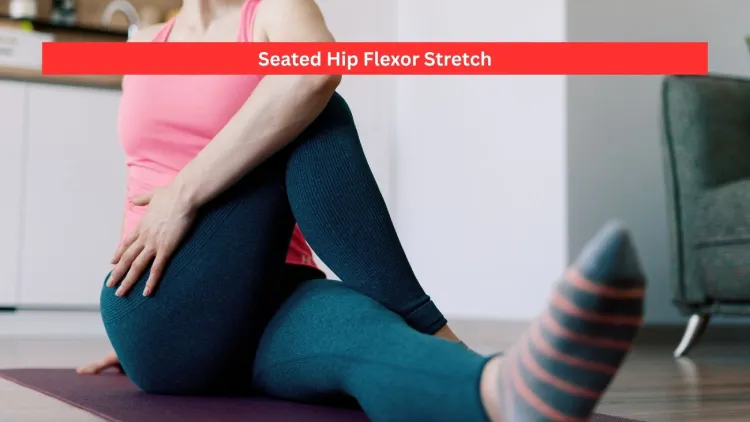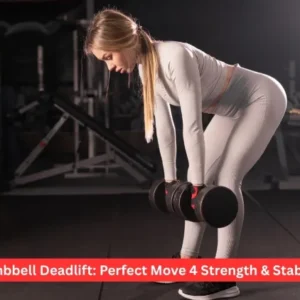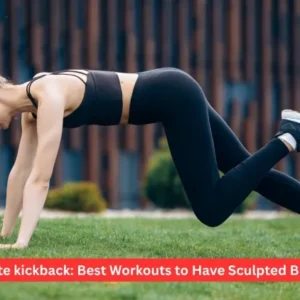Are your hip flexors aching? Well, it is true to say that you spend a lot of your time sitting, either at a desk or in a car or on the couch? Poor posture, limited movement and even lower back pain may result because of shortened/tight hip flexor muscles. Seated hip flexor stretch is one of the best and easiest ways to overcome this. This easy but effective exercise directly activates the iliopsoas and other hip flexor muscles by restoring flexibility to them and eases common discomfort felt in the hip area.
The Seated hip flexor stretch can be used by people of every gender, age, and fitness level: both healthy persons and those who are recovering due to an injury, as well as elderly adults. It can be carried out on a chair or floor and hence can be adapted to any environment, whether at home, work or in a physical therapy section.
Here we are going to teach you what the Seated hip flexor stretch is, why it has numerous physical advantages, and how to perform both seated and floor versions with clear instructions. You will also get to know the frequency of doing the stretch, some mistakes that most people make, the variations that you should make once you become advanced, and whether the stretch is appropriate to your body. And when you are prepared to loosen up stiff hips, to have better posture, and to aid your spine, then this tutorial on the seated hip stretch is just what you are looking for. You can view our previous article if you’re concerned about sciatic nerve flossing.

What Is a Seated Hip Flexor Stretch?
Seated hip flexor stretch is a stretch exercise and is based on the muscle occupying the front part of the hip, which includes the iliopsoas, rectus femoris and sartorius. These muscles act to raise the knee and flex the hip, which we perform most of the time during the day.
The seated hip flexor stretch is an assisted and low-impact variant of stretching out the hip flexor as opposed to standing or kneeling variations. One can perform it sitting in a chair or on the floor; thus, it can be practised by individuals of every age and fitness level.
This would be particularly beneficial to senior persons, those with balance problems, or those recuperating after injuries to the lower body. With a bit of technique and frequency, the seated hip flexor stretch could slowly cause hip tension to reduce and overall comfort and movement to increase.
Benefits of the Seated Hip Flexor Stretch
Not only is the seated hip flexor stretch simple to carry out, but it also has a broad scope of physical advantages it brings. These are the main benefits of including this stretch in your practice:
1. Improves Hip Flexibility
Hip flexors are stiff and limit body movement, more so when the body is performing such activities as walking, climbing stairs or doing lunges. Doing the seated hip flexor stretch can enhance flexibility in those muscles, which increases the level of mobility in your hips and allows you to move freely and easily.
2. Reduces Lower Back Pain
Having tight hip flexors causes a lot of people to have lower back pain because the pelvis tilts forward and creates unhealthy strain on the lumbar spine. Consistently performing seated hip flexor stretches will help you to fix pelvis alignment, and the lower back will have fewer pressures placed on it, which will help in giving relief to lower back pains and tightness.
3. Supports Better Posture
The contracted hip flexors tend to slouch the spine and pelvis out of position into the forward-leaning or slouching position. By stretching these muscles, the spine and the hips are helped to achieve balance and healthy posture.
4. Ideal for Beginners and Older Adults
Since the seated hip flexor stretch can be performed either via a chair or when sitting on the floor, it is extremely accessible to those individuals who might have difficulties with standing or kneeling exercises. It is an excellent starting point for people with limited mobility, seniors, and folks who are beginners.
5. Enhances Athletic Performance
Strong and flexible hip flexors are in demand among athletes who practice such sports as sprinting, jumping, or kicking. An effective method to improve athletic performance and avoid tightness-related or imbalance-related injuries is to do a seated hip flexor stretch in a warm-up or cool-down program.

How to Perform the Seated Hip Flexor Stretch (Chair Variation)
A sturdy chair is one of the simplest means of carrying out the Seated hip flexor stretch. It can be used in offices, during home exercise or after sitting.
Equipment Needed:
- A non-passing chair
- Yoga block or folded towel ( optional to be comfortable )
- Step-by-Step Instructions:
- Place the right hip close to the edge of the chair and the left leg hanging on the side by sitting sideways.
- Put your right foot on the ground and keep the knee horizontally at a right angle.
- Lift your left leg backwards and put the toes or the top of the foot on the ground.
- Push gently out with hips leaning forward, having a straight back and tight abs.
- You ought to experience a frontal stretch in masking the left hip.
- Within 20-30 seconds, hold the stretch and deep breathe.
- Back to position one and go to the other side, and repeat the workout on the other leg.
Additional Tips:
- Do not bend your back; arch it upwards instead.
- Just neutralise your spine by using your core muscles.
- Do not tense your shoulders, and keep your chest open during the stretch.
- Do not force the movement; it must be a rather painless pull.
It makes the seated hip flexor stretch a perfect option during brisk desk breaks or when used in a morning mobility practice.

Seated Hip Flexor Stretch on the Floor
The seated version of the Seated hip flexor stretch on the floor gives a deeper stretch and is excellent for people who want to stretch deeper.
Instructions:
- Star in the sitting position with both legs stretched forward.
- Keep the left knee bent and pull the left heel toward the left buttock, sliding the shin and thigh on the floor.
- Precisely keep your right leg straight and turn your hips forward.
- Extend the vertebra a little or lean on the left hip forward until you experience an elongation in the anterior of the left hip.
- Maintain the position of 20-30 seconds in a slow and steady breath.
- Swap the legs and repeat.
This variation is even more demanding to flexibility, and it will be difficult for people who have knee or hip restrictions. Always keep in the pain-free range.
When and How Often Should You Do the Seated Hip Flexor Stretch?
The flexibility and health of joints lie in consistency. The Seated hip flexor stretch should be done daily or a few times each week, depending on how active you are and how much you need it.
Recommended Frequency:
- General flexibility: 3-5 times a week
- Days of sedentary activity and post-sitting: Daily
- Injury healing or treatment: As recommended by a medical worker
Sets and Duration:
- 6- 8 per leg
- Stretch each of the parts for at least 20 to 30 seconds
Seated hip flexor stretch can be done during the warm-up because of the requirement to distribute heat to the hip area, or during the cool-down period to deactivate the muscles following the exercise.

Common Mistakes to Avoid
As you go along with your seated hip flexor stretch, watch out against the following pitfalls to get the best of it and to prevent overstretching:
1. Beyond Back
One of the mistakes is permitting the lower back to be in an extended position. This imposes stress on the spine and decreases the stretch efficiency. Rather than this, maintain an interaction of the core and neutral hips.
2. Too Much Bent-To-Forward
Another common misconception involves A large number of individualforwardrd wittheir ownos to make the stretch even deeper. This, in fs hip involvement. What is important is to push forward the hip, not to rest the upper body.
3. Jumping During the Rise
There should never be bouncing or jerking into the stretch. This may result in spasm or strain of muscles. Move slowly and keep the position under control.
4. Torso / Hips Twist
Have square hips and shoulders. The movement of rotation can distract the attention of the hip flexors and can cause strain.
By going through these errors to avoid, you will guarantee that your seated hip flexor stretch is safe yet effective and helpful in the long run.
Who Should Avoid the Seated Hip Flexor Stretch?
Despite the safety of the Seated hip flexor stretch in most people, some individuals are advised not to perform the exercise, or they ought to seek medical advice first.
This stretch should be avoided or adjusted when:
- Recent hip or spinal surgery, have had gum surgery, or have had a procedure on the gums
- Do you have an acute lower back ache?
- Have knee joint inflammation or /instability.
- Experience dizziness, walking or sitting in the seated position
In case you are not sure whether seated hip flexor stretch can be included in your condition, consult a physical therapist or a healthcare provider.
Variations and Progressions
After you are familiar with the standard seated hip flexor stretch, it is possible to include variations to improve intensity or variety.
1. Seated Stretch and Side Bend
When in seated stretch, lift the arm on the stretching side and slightly lean sideways. This brings a side body lengthening and a further hip flexor extension.
2. Foot Raised Chair Stretch
Put the back foot on a low stool or yoga block for more force. Hold a correct body posture.
3. Standing Stretch
Once flexibility has increased, move into a lunge stretch with the knee on the floor or standing up, in case one wishes to stretch the hip flexors and surrounding muscles more.
All these variations are more or less grounded on the seated hip flexor stretch and can be manipulated according to your range of flexibility and strength.

Final Thoughts
Seated hip flexor stretch is an easy and dynamic exercise that helps in terms of flexibility in the hips, posture and pain management. During the recovery period of inactive persons and individuals who want to avoid developing lower back pain, this stretch can be employed, as well as for people who need to move better.
Since it does not cause too much impact and could be practised almost anywhere, the seated hip flexor stretch will be a fantastic option for anyone, including office workers and students, as well as seniors and athletes.
With time consistency when performing the seated hip flexor stretch, you should start noticing that your mobility improves, that you feel more comfortable, and that you move better in general.
Frequently Asked Questions
1. My question is, how long do I keep the seated hip flexor stretch?
They suggest that the seated hip flexor stretch should be done for 20 to 30 seconds on each leg. You may repeat the stretch twice or thrice on both sides. Make sure you breathe deeply and do not hurry. The aim is to have a pain-free and strain-free gentle stretch.
2. Is it possible to exercise the seated hip flexor stretch daily?
Of course, you can do a seated hip flexor stretch every day, particularly in case you deal with long sitting or have some tightness in the hips. To maintain flexibility and mobility, it is recommended to do it on most days of the week (3-5 times), but on lazy days, stretching every day may prevent rigidity and unpleasant sensations.
3. Is it safe to use the seated hip flexor stretch among seniors or beginners?
Absolutely. Seated hip flexor stretch has been categorised as the most beginner and senior-safe hip stretch since it is a low-impact stretch exercise and can be performed seated. It allows flexibility and movements without straining knees or lower backs.
4. What do I do when the seated hip flexor stretch is rather uncomfortable?
When you experience sharp pain, or the pressure in the joints, or when it hurts the other person, cease stretching. Do not get stretched or turn your body. Adjust the position to a gentler one or ask a physical therapist whether it is safe with your condition.








2 thoughts on “Seated Hip Flexor Stretch: 5 Great Benefits & Compete Guide”
Hi! This is my first visit to your blog! We are a group of volunteers and starting a new initiative in a community in the same niche. Your blog provided us beneficial information to work on. You have done a outstanding job!
Thank you so much! I’m glad you found the content helpful. Best of luck with your new community initiative—keep up the great work!